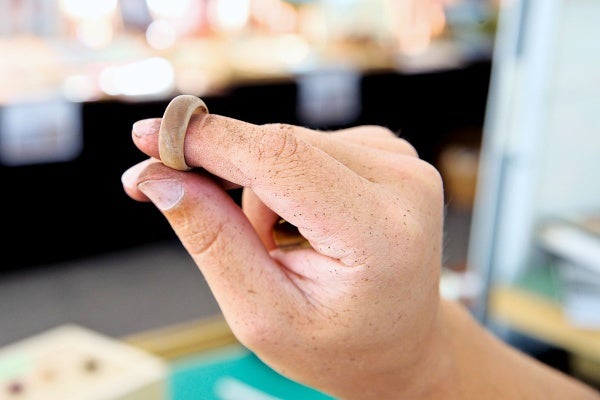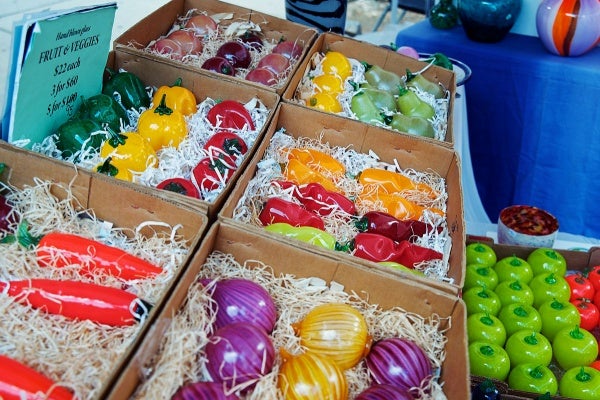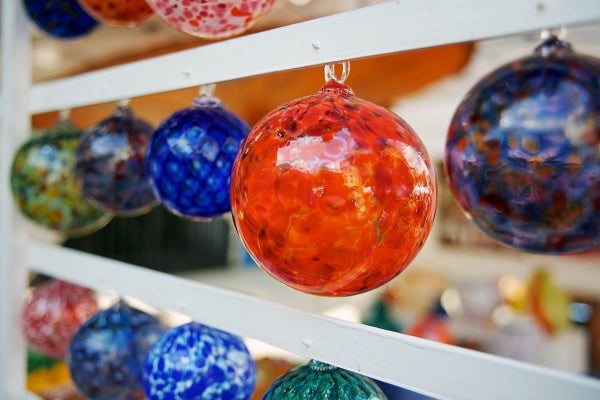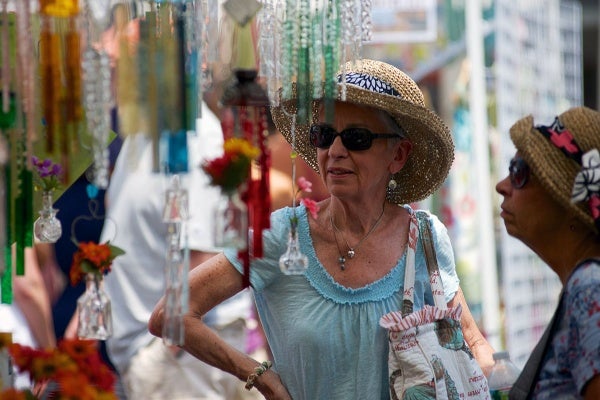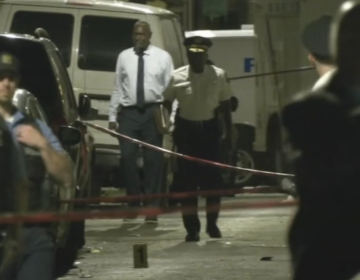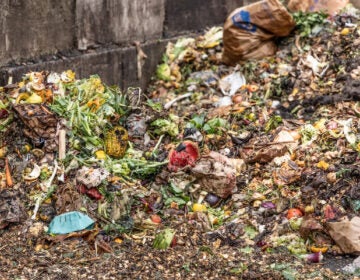A view from the vendor tents at the Manayunk Arts Festival
For the first few hours of a show as big as Manayunk’s 23rd annual Arts Festival, vendors settle in to watch the traffic. Visitors wend in and out of the booths, but few large purchases are made in the opening hours, since potential buyers will make a sweep of the show before returning to the tables of the artisans that caught their eye.
That sweep of the show is a formidable task in a festival as large as Manayunk’s, with almost three hundred tents lining Main Street this weekend in the hot, clear sunshine. On Saturday, emptied water bottles mounded in the recycling bins, patrons struggled to eat their water ice before it melted, and dog-owners scooped their small, panting companions up to ride in their arms through the curb-to-curb crowd.
“Folks walk up and down first. It takes awhile,” said Lititz, Pa. watercolorist Margaret Thorn, manning a booth of vibrant, intricate summertime watercolors, whose subjects included beachscapes, a bushel of Maryland blue-claw crabs, hot, greasy slices of boardwalk pizza and other decadent medleys.
She and her husband – self-described “art slave” Art Thorn, who mats and frames his wife’s pictures, as well as managing her website – are on the road for art shows ten months out of the year, and they are veterans of the Manayunk show.
The challenges of an outdoor show
This year’s weather was hot, but Margaret Thorn remembers the festival two years ago, during one of the hottest summers Philly has ever seen.
“People were walking like zombies,” she said, which was hardly conducive to purchasing paintings. It’s a risk all art show vendors take. For all the cost and effort of setting up and running a booth at juried outdoor shows, you never know if your sales will result in a profit, especially if the weather conspires against you.
But not every artisan has the same goals. Benny Zhang of Brandywine, MD has been bringing his bonsai trees to the Festival for five years. While his tiny, graceful trees usually sell pretty well in Manayunk, his biggest reason for returning to the show is the chance to get his company’s name out there: Celestial Gardens, Inc. has been in the family for over thirty years. Zhang cultivates about 100 different varieties of bonsai, and displayed about fifty on Saturday, including his favorite, the Chinese Elm, which can live for up to 500 years.
Many trees at his booth were over 20 years old, and cost about $80. “It’s a traditional art form” going back over 2,000 years, Zhang said of the way the trees are trimmed and shaped with wire.
Fresh ideas from the first-timers
Georgie Lehoop, on the other side of Main Street, was joining the Manayunk show for the first time this year. A drummer with almost fifty years of experience, he has discovered an unusual way of painting.
“I played in a hundred different bands,” Lehoop said. One day about ten years ago, it hit him. What if he were to dip his drumsticks in paint, and bring his percussion to the canvas?
Purchasers of his paintings – many of which resemble some kind of intergalactic shoot-out, with vibrating planets hurtling through the dark – receive a CD recording labeled “would you like to hear a painting?” It pairs the startling visuals with a specially mastered auditory experience, based on a recording of the actual painting session. Lehoop’s t-shirts, also featuring drumstick-painted designs, seemed popular with young shoppers. He has also begun to create his paintings on abandoned cymbals and records. Gesturing to a bucket full of his well-mottled tools, Lehoop explained that just as sticks, mallets and drum-brushes produce different sounds, they make for different visual patterns on the canvas. Now, called “the rock-and-roll Jackson Pollock” by some patrons, Lehoop’s unique paintings have turned into a full-time career.
Former commercial photographer Greg Knott of Alexandria, Va. was also new to the Manayunk show. He brings his product photography experience to a colorful at-home studio for whimsical “deconstructions” of favorite sayings or ideas, like the food pyramid, Rock Paper Scissors, and Duck, Duck, Goose. With crisp, luxurious focus and richly colored backgrounds, one of his large triptychs featured marshmallows in one panel, graham crackers in the next, and a chocolate bar in the third.
By mid-afternoon on Saturday, Knott had already sold about $2,000 worth of work – pretty good, in his experience of doing about 20 art shows per year. The Manayunk show, observed this dad of two, “is so packed you can’t even push a stroller.”
A slower day for some
Things were a bit slower for photographer and printmaker Charlie Barton, whose image of Baltimore scullers graced the Festival’s official poster.
In his experience, most of the buying at weekend art shows like Manayunk’s happens on Saturday, as serious shoppers are loath to wait until Sunday to turn out, when the choicest pieces may be gone. As of mid-Saturday afternoon, he had sold about five pieces, but was slightly disappointed to see that instead of buying the much-admired $125 limited-edition print of the scullers, many patrons picked up the Festival poster, and then asked Barton to sign it. But he cheerfully complied, even thinking to keep a tally of the number of posters he had signed.
He felt that the sheer volume of vendors at Manayunk’s show might prove overwhelming to patrons, and hurt sales.
“If you’re from a gallery, you’ll make it all the way through,” he said. But it’s probably a different story for those who aren’t arts professionals.
Going beyond breaking even
Thorn noted that the pressure to turn a profit at Manayunk’s show is even greater than usual: the $450 fee for a booth is the highest one she’s ever seen. Add in travel and two nights’ hotel (and, as Knott says, a weekend away from the family), and the costs pile up. A few artists estimated that they had to sell at least $750- $1000 worth of work in two days just to break even.
If he makes $10,000 during a show, Knott says, “I’m ecstatic.” But a few thousand is alright too.
The Thorns were glad to be “in the black” by about 5 p.m. on Saturday. For them, a weekend show is going well if they can recoup their costs in the first day, and still have one day to try for a profit. They love teaming up on the often “grueling” work of packing and unpacking for art shows.
“It’s a mom and pop business for us,” they said. “We always hope it’s a good show, because we love to come to Manayunk.”
WHYY is your source for fact-based, in-depth journalism and information. As a nonprofit organization, we rely on financial support from readers like you. Please give today.



















